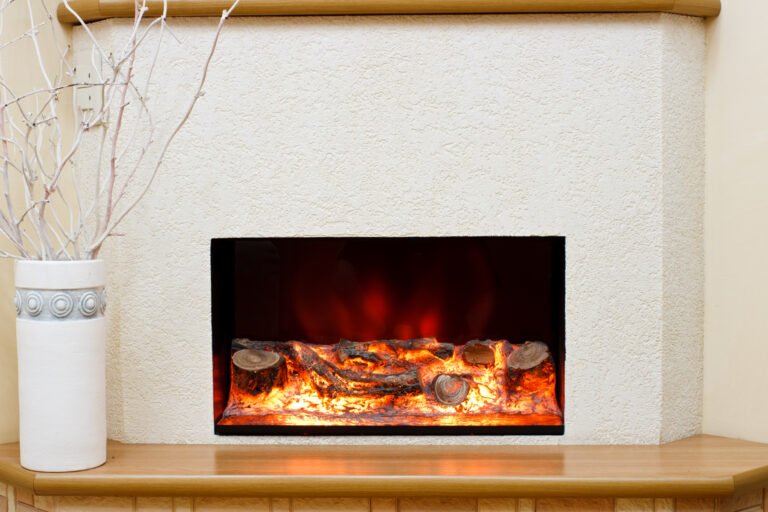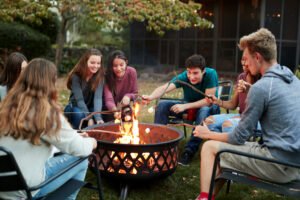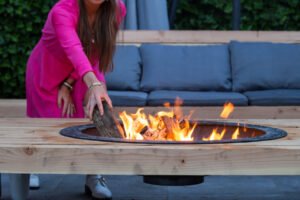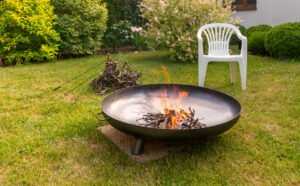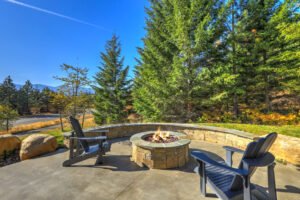Fire pits are the best addition that can transform your backyard into a stunning outdoor fireplace. However, the smoke they produce and the environmental harm they may cause stop many people from using a fire pit.
Not only that but sometimes, a fire ban also restricts people from enjoying the incredible warmth and ambiance of the fire pit. But there is a piece of good news for you! To enjoy a great campfire-like experience, you don’t need an actual traditional fire pit.
All you need are some great alternatives to the regular backyard fire pit. So, we are here to make your job easier by providing the top 10 fantastic fire pit alternatives that will change your fire pit experience.
Top 10 Fire Pit Alternatives For Your Backyard
1. Solo Stove Bonfire
What is It: A solo stove bonfire is a small, simple, lightweight, and portable fire pit that gives out a smoke-free flame and radiates less heat than conventional fire pits.
How does it work: Solo stove has a 360° airflow technology that pulls air from the bottom and fuels the fire at the top by supplying more oxygen to the chamber’s upper vent holes.
Solo Stove has a double-walled stainless steel structure that promotes airflow but reduces smoke, ash, and radiant heat. It is 12.5 inches tall and weighs about 15 pounds, making it lightweight, portable, and easily mountable on decks. Alternatively, you can even use 16-inch long stoves for permanent installation on the ground.
Pros:
- It’s Smokeless, Portable, and gives out an Ultra-hot flame
- Log-friendly and mimics the appearance of a traditional Bonfire
- Durable, Long-lasting, and Polished
- It does not rust easily, especially when covered with a rain cover
- It comes with a lifetime guarantee for repairs and maintenance
Cons:
- It might discolor after the first or several burns
- It might develop a green oxidation layer if left under direct sunlight for a long time
Always use a stove stand when installing the solo stove on a deck, as direct contacts might discolor the deck or blacken it.
2. Propane Torches
What is It: Propane torches are simple ignition tools that use a propane gas canister and a precision torch to produce a smaller but blazing flame.
How do they work: These torches suck the outside air by a vacuum created in the gas tube, mix it with propane and push it out through an ignition tube that makes a spark and ignites the fire.
Propane torches are lightweight, portable, and easy to use. These use a 45° angled brass burner tube that allows complete control over the flame and prevents any reverse anti-glare. Moreover, these torches use hydrocarbon gas as fuel; thus, they are a sustainable alternative to wood-log combustion but ensure the same warmth and light as any fire pit.
Pros:
- They have On-and-off triggers that control fire and prevent a mishap
- Heavy-duty and easy-to-clean
- Have more extensive flame adjustment ranges – Broad, Small, Medium, and Large
- Includes Flint Strikers that help ignite a fire
Cons:
- Require manual flame striking with a matchstick
- It might turn black with time
Propane torches might backfire on the flame due to clogging or leakage and need immediate cleaning or replacement to avoid burns.
3. Barbeque Grill
What is It: A barbeque grill cooks food by supplying it with low heat from below but produces enough radiant heat in all directions.
How does it work: A barbeque grill has steel slits or rods that absorb heat from the burning charcoal and conduct it to the food above. The food’s exterior face reabsorbs this energy and radiates it to the center, ensuring a uniform roast and no burning.
Barbeque grills are a smart alternative to lawn parties as they not only produce smaller and lighter flames but also provide warmth and quick cooking.
Moreover, they are about 14 inches long and 3 pounds in weight, allowing easy folding and portability whenever required. You can even use a 100-pound steel grill if you want a stationary barbeque for your lawn.
Choose an offset smoker with a horizontal cooking chamber and firebox for a mess-free, cleanable barbecue on a budget.
Pros:
- Convenient to use and highly portable
- Temperature control over the whole grill
- Easy to ignite and Quick cooking
Cons:
- Grills disrupt the overall air quality of a space, and the smoke might cause allergies
- Burning develops soot over the grill and requires heavy cleaning
Warning: Dripping oil or fat can cause the grill flame to flare up and cause a mishap. Hence, always brush the oil lightly and remove any crumbling pieces immediately.
4. LED Flame Lights
What are these: LED flame lights are simple light fixtures with smaller Candelabra bulbs that stimulate gas flames but do not produce heat.
How they work: LED lights are semi-conductive and work on the gas pressure mechanism. These bulbs contain gallium phosphide electrodes that heat up and break down the excess voltage to different chips that flicker and recreate a fire flame inside the bulb.
LED flame lights are a heat-free fireplace alternative for the summer and operate on a remote that controls their brightness, lighting modes, and effects efficiently.
These have three modes – Breathing ( alternate dining and brightening of the flame ), Flame emulation ( realistic, heavy intensity flame), and General LED Lighting that maximizes visibility.
Moreover, these are cost-effective and durable, lasting 60,000 hours on a 2-watt energy source. And they produce about 100 lumens of light, bright enough to illuminate your campsite!
Pros:
- Energy-efficient and uses 80% less energy than simple halogen bulbs
- Provide light, but do not warm up the camping site
- Do not contain toxic compounds and reduce carbon emissions
Cons:
- These may have a higher upfront cost and additional installation charges
- These produce blue light and might disrupt sleep
LED Flame lights do not have a battery indicator. Hence, always carry additional USBs or batteries to recharge them when traveling.
5. Portable Fire Pit
What is It: Portable fire pits are small, stainless steel or aluminum fireboxes that hold wood or charcoal and produce a blazing flame once ignited.
How it works: Portable firepits have an assorted fire mesh that supplies air and oxygen to the fire and enhances the flame on ignition. Additionally, these meshes absorb most carbon emissions and reduce the smoke generated.
A portable fire pit is lightweight, easy to carry and operate, and the best tap for a traveling camper and camp chef. These hold about 125 pounds of combustible material and last for 600-700 hours on moderate flame.
Further, these do not create much mess and cool down in 90 seconds, making them readily accessible at all times.
Moreover, while there are different types of portable fire pits available in the market – gas-fueled, gel-fueled, and wood-fueled, you can use a simple pop-up fire pit that’s foldable, reusable, and provides a long time burn. Plus, you can also add a grill plate that will allow you to enjoy food while on a camping trip!
Pros:
- Lightweight (8 pounds), Foldable, and Easy to carry
- Withstands rapid heating and cooling
- Easy to set up on any camping site
- It has a heat shield that prevents excess heat or burning
Cons:
- Different parts do not lock or latch and can be challenging to move once set
- The fire mesh needs replacement after 40 – 50 uses
Precaution: Always place the heat shield at least 5-6” apart from the fire mesh to prevent it from burning or weathering.
6. Electric Fireplace
What Is It: An electric fireplace is an electric heater that mimics the flames of a conventional fire pit, using an electric supply, heat sources, and LED flame effects.
How it works: Electric fireplaces have a small heating chamber that absorbs air from the camping site, heats it using heating coils and infrared technology, and supplies it outside using a propeller fan.
Electric fireplaces come with a remote that adjusts their light, temperature, and colors. These don’t create a fire mess as they run without wood and need little maintenance and cleaning.
They have metal clips and stands and can be freestanding, wall-mounted, or deck-mounted, depending on the site. Additionally, you can even control their brightness and flame speed, use it as a patio heater, and save energy.
Pros:
- Lightweight (about 2.6 pounds) and Portable
- Do not require chimneys, vents, or gas tubes
- Are easy to install or mount
- Economical and Safe to use
- Sustainable and Does not require wood for burning
Cons:
- Requires more energy and hikes the bill
- Not realistic as a natural fire
- You cannot keep it outside for long
Never clean the inlets and outlets of an electric heater with a wet cloth as it may shoot the circuit and burn the heater. Instead, clean them using a dry microfiber fabric or vacuum.
7. Outland Fire Bowl
What Is It: An outland fire bowl is a small, stainless steel bowl with chrome knobs and a 5-gallon propane tank that ignites fire whenever required.
How it works: Outland fire bowls have a hose and regulator that directs oxygen to the tip of the propane canister, creates a strong air seal, pressurizes the gas, and produces a roaring flame of 58,000 BTU.
Outland fire bowls are minimal and clean fire pits that burn using a propane tank cylinder, adjustable regulator, and lava rocks. These steel bowls are not only durable and energy-efficient but are CSA-approved and work even during campfire bans.
Moreover, they do not produce smoke and fly ash and are the right tap for campers and beach parties. Overall, an outland fire bowl is safe, compact, portable, and produces a moderate flame.
Pros:
- Sustainable and does not need wood logs for burning
- Controls the heat output and flames
- Sturdy and does not dent or corrode
- Smokeless and ash-free
Cons:
- These have a high initial cost and might feel bulky
- Produce yellow, carbon-emitting flames that might cause skin issues
- Vulnerable to clogs
Warning: Never store gasoline or any other flammable substance near the Outland fire bowl, as it might catch fire or blast.
8. Propane Stoves
What Are These: Propane stoves are small and portable. Cast iron, aluminum, or stainless steel stovetops with propane or gas barbeques radiate heat and cook food on the top.
How they work: Propane stoves have a small gas or electric pilot light on one side of the burner that ignites the oxygen in the burner tube, pressurizes it, and produces a large flame that cooks food.
Propane stoves are sturdy, heat-resistant, and durable. They are not only sustainable but also reduce the smoke and ash accumulations, thus allowing an open barbeque for outdoor cooking.
Moreover, these come in two sizes, and you can use the single portable burner if you are a camper while preferring a double burner for the family backyard.
Additionally, they are highly affordable and cost about $100 for a single stove and $150-200 for a double stove. Plus, these are perfect for brewing, camping, and cooking and have a 0.2psi adjustable steel regulator that controls their operations.
Pros:
- Does not burn wood logs and emit hydrocarbons
- Non-toxic and Clean, mess-free burns
- Refillable stove tanks that don’t need replacement
Cons:
- Propane stove flames are comparatively shorter and broader
- High upfront cost or Installation
- Requires periodic inspections to check for leaks or holes
Warning: Never store your propane stoves at temperatures above 120°F or in direct sunlight, as these may leak and cause a mishap. Instead, disconnect the hose from your propane canister and store it in a cool, dry place.
9. Smokeless Fire Pits
What is It: Smokeless Fire Pits are secondary combustion devices that burn the combustible material but catch the smoke before it escapes into the air. Therefore, they are not ‘smoke-free’ but reduce the overall emission percentage.
How they work: These pits have O-shaped rings with holes at the top that draw air to the outer wall and expand it to the inner wall of the ring. This separates the oxygen from the air, creates a spark, and ignites the flame.
Smokeless fire pits give heat, light, and warmth. Of course, they are not that efficient in cooking, but they offer less smoke and don’t block the visuals. Instead, they use a high-temperature output technology and a secondary combustion mechanism that traps the smoke inside and offers a clean, mess-free campfire.
Smokeless fire pits come in various models like Cast Master Bon 2000 Smokeless Fire Pit and Grill and BioLite FirePit+ Smokeless Fire Pit. Each has a different design, size, and type that suits various purposes, from brewing to actual cooking.
Pros:
- Less smoke than a traditional fire pit
- It has stronger ventilation that makes it easier to ignite
Cons:
- It gives lesser warmth and heat in comparison to a traditional fire pit
- It is pricey and challenging to maintain
Smokeless firepits are available in charcoal, fuel, and gas-based operations. So, pick propane fire fits for your gazebos and decks, choose fuel-based fire pits for campsites, and go with charcoal for barbeques.
10. Artificial Fire Lamps
What Are These: These are small, battery-operated plastic lamps with flickering LED lights that stimulate a fire-like appearance.
How they work: These lamps primarily work on an electrical circuit and heating mechanism. Each of these lamps has a tungsten filament underneath that heats the electrical supply and gives a fire effect with moderate flame.
Artificial fire lamps are great for camping sites with fire bans or restrictions, but they do not provide the warmth and light of a traditional fire pit. However, they provide a great ambiance and work on silk cloth, flickering LED lights, and bottom fans, giving an extraordinary campfire effect.
Although they aren’t sturdy and durable, they are the best bet for summer camps.
Pros:
- Highly affordable and cost about $20-40
- Don’t go out with the wind, and ensure a consistent ambiance
- Don’t flicker or go dim
Cons:
- No natural heat and light
- You’ll need to replace them after 3-5 months or after 2,000 hours of use
- They are energy-consuming and hike the electricity bill
Precaution: Artificial fire lamps might cause red eyes or eye irritation. Hence, never stare at the lights for too long, and if possible, sit at a distance to prevent direct exposure.
Eco-Friendly Fire Pit Alternatives
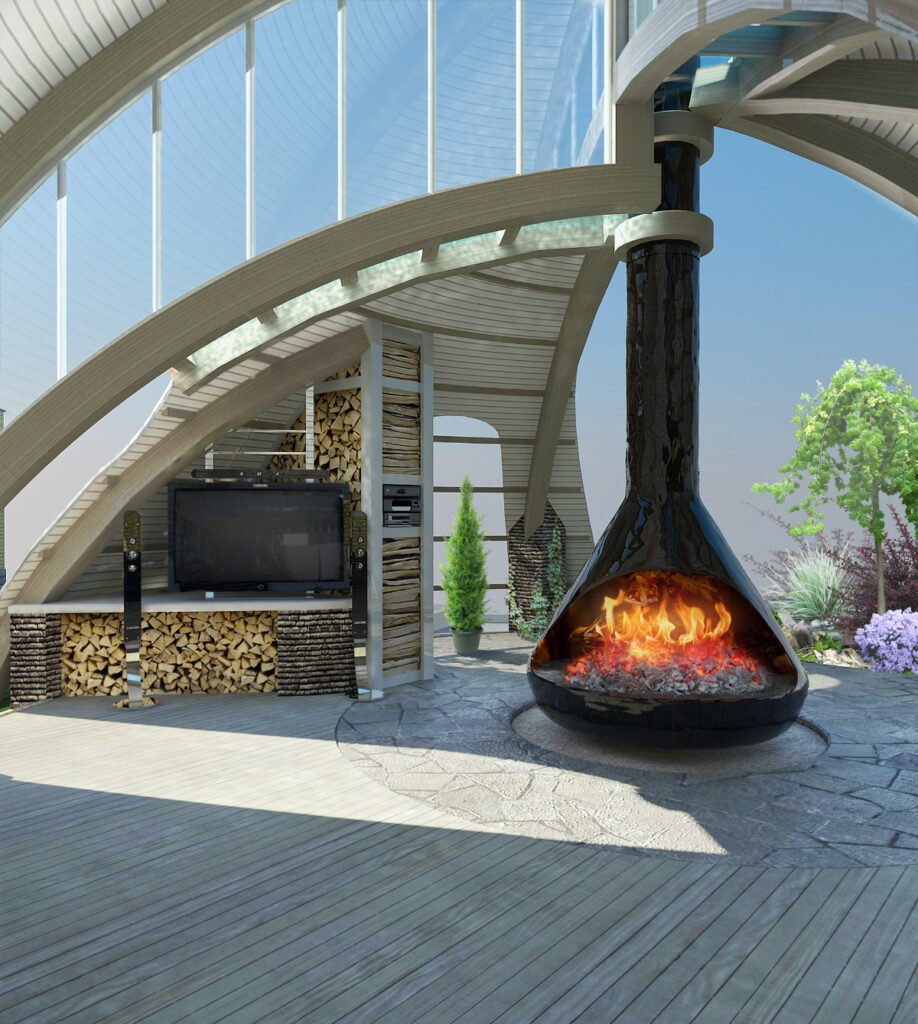
If you are one of the people who has sacrificed campfires and fireplace parties because of your environmental concern, then we have a solution. You can now enjoy your bonfire with the slightest worry about ecological harm by using the options below:
1. Environmentally Safe Topping Materials
To make fire pits run by gas even more environmentally friendly, topping materials such as lava rocks, fire glass, and treated river stones would be needed. Fire glass is a sustainable material that does not exude harmful toxins.
Also, lava rock and other approved stones are eco-friendly and heat resistant, which can withstand permanent high temperatures. Plus, they look modern and stylish and can help decorate your fireplace easily.
Always use approved and suitable topping materials as other unapproved materials can lead to explosions.
2. Energy-efficient Natural Gas
Fire pits run with natural gas are quick in lighting, and provide long-lasting burning. In addition, they are sustainable, energy-efficient, and do not harm the environment.
Natural gas burns cleaner and releases less toxic gases and fumes than wood fire pits that use wood logs to burn. Also, as the gas is clean, you can relatively breathe normally around natural gas fire pits even with health conditions such as asthma or breathing issues.
3. Ecological Gel Fuel
Gel fuel fireplaces are more efficient and environmentally safe to use. Gel fuel is cleaner and eco-friendly. It produces fewer toxins, chemicals, and harmful gases in the atmosphere. Also, the amount of carbon dioxide produced by a gel fireplace is significantly less.
Follow the manufacturer’s manual while handling, storing, and using gel fuel, and never touch the canister with bare hands as it might irritate the skin.
4. Sustainable Bioethanol
Bioethanol is an excellent sustainable alternative to wood and propane because it is a cleaner fuel. You can find bio-ethanol fire pits with amazing designs, styles, and sizes that cater to even niche needs.
For rare uses, you can create a small bioethanol fire pit rather than a large wood-burning fire pit. However, it is necessary to maintain a safe distance and keep safety accessories nearby to avoid mishaps.
For more awareness, learn about some common fire pit mistakes and make sure to AVOID them.
For a more environmentally friendly attitude, try to be minimal by using fewer things in your backyard, which would lead to less wastage. Also, transform a fire pit in ways that can be used for various things like a grill, center table, etc.
Wood Log Alternatives to Burn in a Wood-burning Fire Pit
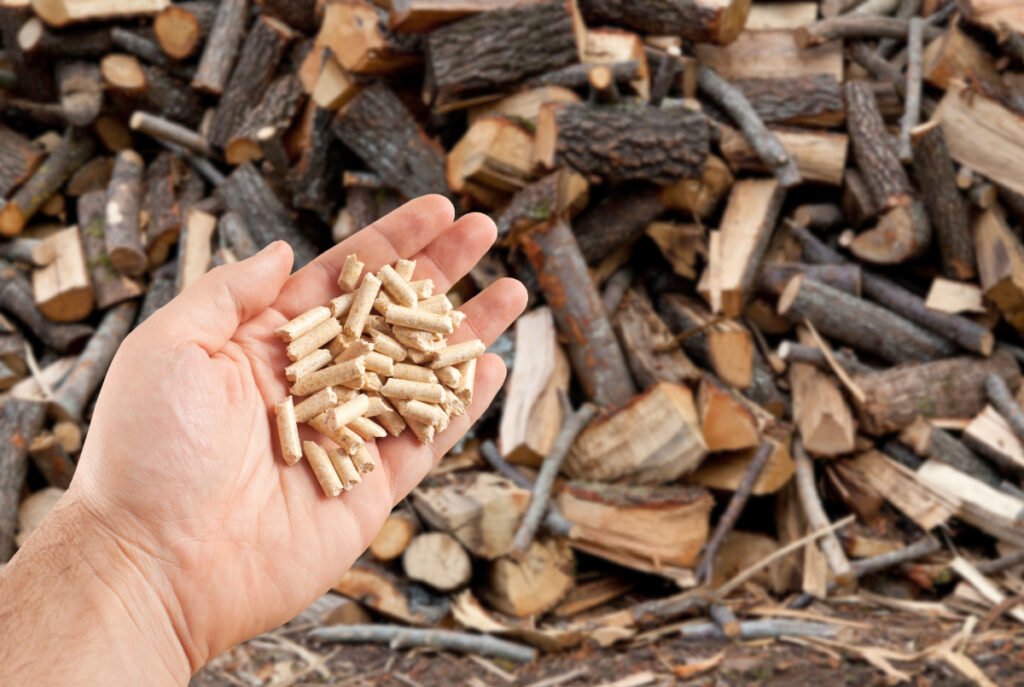
If you have a wood-burning fire pit but still do not want to harm the environment by burning wood logs, some great sustainable options can replace the logs. Here are some of the best wood alternatives:
- Wood bricks and Pellets: Wood pellets and bricks are made from recycled, condensed, kiln-dried sawdust, wood chips, and scraps from lumber mills. They are cleaner and burn more efficiently than firewood.
- Recycled Coffee Bean Logs: Briquette logs are made from recycled coffee grounds that contain a lot of energy. You can dry them and burn them to get more heat than regular firewood. Also, they produce fewer landfills.
- Nonpetroleum Natural Gas Logs: Logs made from sawdust and plant-based waxes are a great sustainable option that causes minimal environmental harm. However, do not use petroleum-based wax logs that produce toxins and chemicals.
- Soy and Switch Grass Logs: Logs made from a 50% blend of switchgrass and soy wax are very efficient and eco-friendly. They use a natural wax as a binder that doesn’t leave residue or mess after burning. Need more insight on what to burn in a fire pit? Follow us.
To make a DIY fire pit using any container, first, fill the container with non-combustible material such as stones or glass beads. Finally, place 2 or 3 bio-fuel cans, hide them with some stones, and light them with a lighter whenever needed.
What is the Most Environmentally Friendly Fire Pit?
The most environmentally friendly fire pit is a natural gas or propane fire pit that produces fewer toxins than a wood-burning fire pit. In addition, these low-maintenance cleaner fuels exude less smoke, residue, or odor and are approved with a green seal.
Can you use a Planter as a Fire Pit?
Yes, you can make a DIY fire pit with a flower pot. First, spray a nonstick cooking spray inside and fill it with concrete. Next, place a gel fuel canister to create the right space with rocks and beach glass in the wet concrete. Finally, remove the container when the concrete dries.
What is a Dakota Fire Pit?
A Dakota fire pit is a simple smokeless fire pit. You can build it by digging two holes in the ground. One hole is to put the firewood, and the other is to have a daft of air. Then, place small logs with combustible material on top inside the fire hole and light it.
Fire pit alternatives are the need of the hour if you want unique, eco-friendly options for your fireplace. Both artificial and natural sustainable fire pits will provide the warmth and ambiance you are looking for.
Thus, the above-mentioned options will help you choose the best alternative to fulfill your needs! However, after finalizing your sustainable outdoor fire pit, deciding on a surface to place it on becomes crucial. So to know if you can put your fire pit on a deck or grass, check this out!

